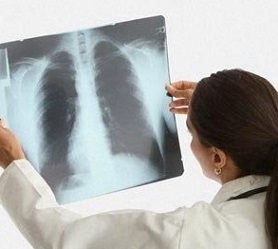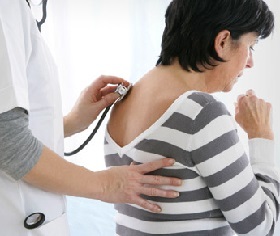 Pneumonia - acute infectious and inflammatory disease, with focal lesion of respiratory departments lung, intra-alveolar exudation, pronounced feverish reaction and intoxication of the body.
Pneumonia - acute infectious and inflammatory disease, with focal lesion of respiratory departments lung, intra-alveolar exudation, pronounced feverish reaction and intoxication of the body.
According to the frequency of deaths, pneumonia is the first among all infectious diseases of the place. Until the moment when penicillin was discovered, every third person died of infection. Currently, only about 3 million people suffer from pneumonia in the United States each year.
The disease can arise from various pathogens - bacteria, viruses, fungi. Therefore, there are a large number of types of pneumonia, each of which has its own symptoms and peculiarities of percolation.
Symptoms of pneumonia are manifested by coughing, runny nose, weakness. The temperature rises, there is pain in the chest, when cough sputum separates from pus and mucus.
Causes
How does pneumonia develop, and what is it? The disease occurs when a microbe enters the weakened human body, which can cause inflammation. The most common pathogen is pneumococcus (40 to 60%), staphylococcus (2 to 5%), streptococcus (2.5%). Atypical pathogens - mycoplasma, legionella, chlamydia, hemophilic rod, viruses. The viruses of parainfluenza, influenza, reoviruses and adenoviruses contribute to the development of the disease.
The etiology of the disease depends to a large extent on the conditions of its occurrence (home, hospital, etc.), and from the age of a person, so these factors must be taken into account when prescribing antibiotics for the treatment of pneumonia.
It is proved that the effect of provoking factors several times increases the likelihood of developing pneumonia. The risk group includes adults with congestive heart failure, chronic bronchitis, elderly people, weakened and emaciated patients with a long bed rest. Particularly susceptible to the development of pneumonia, smoking and alcohol abusing adults.
Symptoms of pneumonia
 In the case of pneumonia, the symptoms in adults largely depend on the cause of the disease, and the extent of lung tissue damage. Nevertheless, all types of pneumonia are characterized by common signs, which are to some extent found in all patients.
In the case of pneumonia, the symptoms in adults largely depend on the cause of the disease, and the extent of lung tissue damage. Nevertheless, all types of pneumonia are characterized by common signs, which are to some extent found in all patients.
Typical first signs of pneumonia include general toxication syndrome (chills, fever, malaise) and bronchopulmonary-pleural (cough, dyspnoea, sputum, auscultatory and percussion signs).
Common signs of pneumonia, which should alert you:
- persistent cough;
- catarrhal diseases lasting more than 7 days, especially when the improvement is followed by a sharp deterioration in the patient's condition;
- severe cough with deep breaths;
- decreased appetite;
- temperature and runny nose, accompanied by pale skin;
- general weakness, dyspnea;
- absence of positive dynamics and decrease in temperature when taking paracetamol (esfergan, panadol, tylenol).
Symptoms of pneumonia in adults are manifested sharply: the temperature rises to 40 ° C, the chest starts to ache with inspiration and exhalation, a cough appears - at first dry, then with sputum discharge.
The disease is dangerous because it is very difficult to diagnose and the time spent on diagnosing can be missed, which can lead to serious consequences. Pneumonia, the symptoms of which are often similar to those of colds or flu, and there may not be any local signs of pneumonia in some patients (about one in five).
Therefore, when the first suspicious symptoms appear, you should consult a doctor, he will carry out a diagnosis, and then confirm or deny your suspicions. If it's pneumonia, how to treat it correctly will tell the lung specialist.
Croupous pneumonia - symptoms
Croupous pneumonia is a process that captures the entire lobe of the lung or its greater part. Croupous pneumonia begins, as a rule, sharply, suddenly. There is a high fever, chills, weakness, headache, and pain in the side, which increases with breathing and coughing. Characteristic of severe dyspnoea and unpleasant sensations in the chest, cough, profuse sputum. There's no rhinitis.
On the patient's face there is a feverish flush. Breathing increased to 30 or more in 1 min. When breathing, swelling of the wings of the nose is noted. The patient takes a forced position on the sore side, as this limits the respiratory movements of the patient's half of the chest, reduces pain, facilitates the breathing of a healthy lung.
Obligatory hospitalization and compliance with sick bed rest during the entire period of fever and intoxication. Patients should periodically change their position in bed, which facilitates expectoration of phlegm.
Focal pneumonia - symptoms
The onset is usually not acute, for several days the prevalence of viral infection: a gradual increase temperature to febrile digits, runny nose, cough dry or with sputum separation of mucous nature, weakness.
Objective data for focal pneumonia are characterized by increased respiration to 25-30 per min., Tachycardia to 100-110 beats. in minutes, muffled heart tones, hard breathing, sonorous wet rales. In the presence of concomitant bronchitis, scattered dry rales are heard; in the case of the adherence of dry pleurisy - the noise of friction of the pleura.
Atypical pneumonia - symptoms
Symptoms of the disease depend on what pathogens it was caused - mycoplasma, legionella or chlamydia. Mycoplasmal pneumonia in children and adults manifests itself in the form of a sore throat, runny nose, an enlargement of the cervical lymph nodes and a headache. The embarrassment in the chest and sputum for this form of the disease are uncharacteristic.
Legionellosis atypical pneumonia is accompanied by dry cough, pain in the chest, high fever, diarrhea, slowing of the pulse and kidney damage.
Pneumonia in adults without fever
In adults, pneumonia can occur without fever - this is the situation when the following symptoms appear: weakness, shortness of breath, excessive sweating, cough, but there is no temperature reaction. It usually occurs with a decreased activity of the immune system.
If after a previous flu, bronchitis, cold, you are still persistent cough, then immediately consult a doctor to avoid complications.
Complications
Pneumonia can lead to the development of a number of consequences from the lungs:
- acute respiratory failure;
- pleurisy;
- bronchoobstructive syndrome;
- acute vascular insufficiency (collapse);
- acute respiratory distress syndrome (noncardiogenic pulmonary edema);
- infectious-toxic shock.
Also, the lethal outcome can lead to the development of cardiovascular failure.
Graft
Vaccination against pneumonia is done to children starting at the age of two. Prevention of inflammatory lung damage in children is an important component of the strategy to reduce the level of infant mortality in modern society. One of the most effective methods of preventing pneumonia is vaccination.
Among the most popular vaccines against pneumonia are French Pneumo-23 and American Prevenar. The drugs are administered intramuscularly and subcutaneously. Adverse reactions are possible in the form of edema, redness, tenderness at the injection site. But in most cases, local manifestations quickly pass.
Treatment of pneumonia
In pneumonia, treatment in adults usually depends on the severity of the disease, the age of the patient and the presence of complications. The need for hospitalization is determined by the doctor.
In the period of acute phenomena it is necessary to comply with bed rest, use of warm drink, high-calorie nutrition, rich in vitamins. It is also useful to eat fruit, vegetable, berry juices and vitamin teas, as well as fruit cocktails from cranberries, currants, gooseberries. If necessary, inhalation of oxygen can be prescribed, as well as expectorants - in the presence of viscous, hardly detachable sputum.
The main thing in the treatment of pneumonia is the use of antibiotics. Prescribe antibiotic therapy should be as early as possible, without waiting for the definition of the pathogen. The choice of an antibiotic is performed by a doctor, there can be no question of any independent treatment at home.
Until recently, most often used ampicillin in combination with clavulanic acid - augmentin. However, modern data indicate a high resistance to these antibiotics. Macrolides of the new generation come first. If the drug was chosen correctly, after a day, the general condition improves and the temperature normalizes. In this case, pneumonia is treated for 5-6 days.
Treatment of pneumonia with folk remedies in adults is possible only as an additional, but in no way basic. It is recommended to use a large amount of onions and garlic, honey, propolis, hips, elderberry, raspberries. In the absence of timely and proper treatment, pneumonia causes severe intoxication of the body, as well as various complications - pleurisy, abscess of the lung, acute respiratory failure and other unpleasant consequences.

How to choose probiotics for the intestine: a list of drugs.

Effective and inexpensive cough syrups for children and adults.

Modern non-steroidal anti-inflammatory drugs.

Review of tablets from the increased pressure of the new generation.
 Antiviral drugs are inexpensive and effective.
Antiviral drugs are inexpensive and effective.



